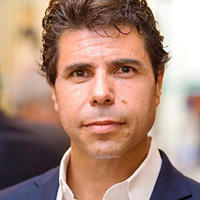Two years from now, 5G technology is predicted to host 25 billion device connections. Imagine that you are a market analyst, and you needed to forecast the number of 5G connected devices in the year 2025, less than 1500 days from today. You might try and calculate this by considering how many humans are on the planet, but that would simply not explain how there will be 25 billion devices in only two years - yet there are only 7.9 Billion people on the planet right now. That essentially means that every person in the industrialized world will have more than 3 connected devices.
If you took a conservative approach, predicting that there would be 50 billion 5G connected devices by 2025, you would be caught short, as the actual prediction is 75 billion 5G connected devices by the year 2025. Lets stop for a moment and let that soak in – 75 billion 5G connected devices in a world populated by 8 billion people. That is more than 9 devices per person.
It is easy to contemplate the enormous opportunities that 5G presents for all industries. This is more than just the ability to see videos faster. Every critical infrastructure sector will be able to function with previously unforeseen high-quality services, maximizing not only business profits, but also service efficiency.
There is, however a seriousness consideration to this new technology; data security. Where should data security be assigned? Who should hold the responsibility of ensuring the data is secure? One solution is a “shared responsibility” model, which, by its name alone, infers how complex this new technology is; simply too big for one security custodian.
From my own professional experiences of occupying roles in the implementation of security solutions within some of the world’s largest organizations, as well as once holding a government classified technology position, I thought it would be interesting to explore some of these ideas with a like-minded security professional.
In this episode of the Thales Security Sessions Podcast, I spoke with Prashant Deo, the Senior Information Security Consultant at Tata Consultancy Services (TCS). Prashant has over 20 years of experience in lead roles in Cyber Security Consulting and Cyber Defense Operations. He currently serves as the Service Delivery Lead for Security Solutions and Services at TCS, managing end-to-end project delivery for Infrastructure Security Solutions and Identity & Access Management Solutions, Security Operations Management and Management of Information Security for all client deliverables.
We can celebrate all of the advances that will occur as a result of 5G, but this high-speed, low-latency data movement also creates an acceleration of security concerns. Data transmission and storage will create a faster set of cascading events that must be met with equally powerful security.
Many cybersecurity professionals are concerned about 5G security, and many people may even misunderstand the problem, assuming that 5G is simply a faster version of what previously existed. However, 5G is not simply a bigger valve that was opened up on an invisible pipe. It is fundamentally different in its design. The entire security core is different than earlier wireless technologies. The virtualization and shared infrastructure aspects of 5G are unique.
Of course, with all technology, complexity is the enemy, and these new advances mean that the attack vectors will also increase. The security implications of 5G are brought to the real-world, for example, when we consider the interactions of autonomous vehicles. These vehicles must operate in harmony with other vehicles, weather, and pedestrian conditions. This data will all be fed from disparate systems, and the automobiles will also generate data back to those systems.
Another part of the shared responsibility model is the interconnection between the cloud service that holds all the data, and the service provider that delivers the data. As Prashant points out, there are more components to the shared security model; it is a full ecosystem. When we think of the split-second decisions required to operate an automobile, it becomes clear how a breakdown of any of the components that comprise that ecosystem can have tragic consequences.
It is evident that when 5G is fully implemented, every entity involved will have to enhance security to handle the broader responsibilities that make 5G so desirable. Why is data security and privacy heightened in this new environment? A simple explanation is that with this new technology, the average person will produce 1 Gigabyte of data per day. To put that into perspective, the contents of an entire doctoral thesis does not generate that much data.
We all want the benefits of 5G technology. It will certainly improve our lives, but we cannot enter into this new arena without a well-planned security model. Tune in to hear our discussion surrounding this intricate challenge.

 Chen Arbel | Associate Vice President, Business Development, 5G
Chen Arbel | Associate Vice President, Business Development, 5G